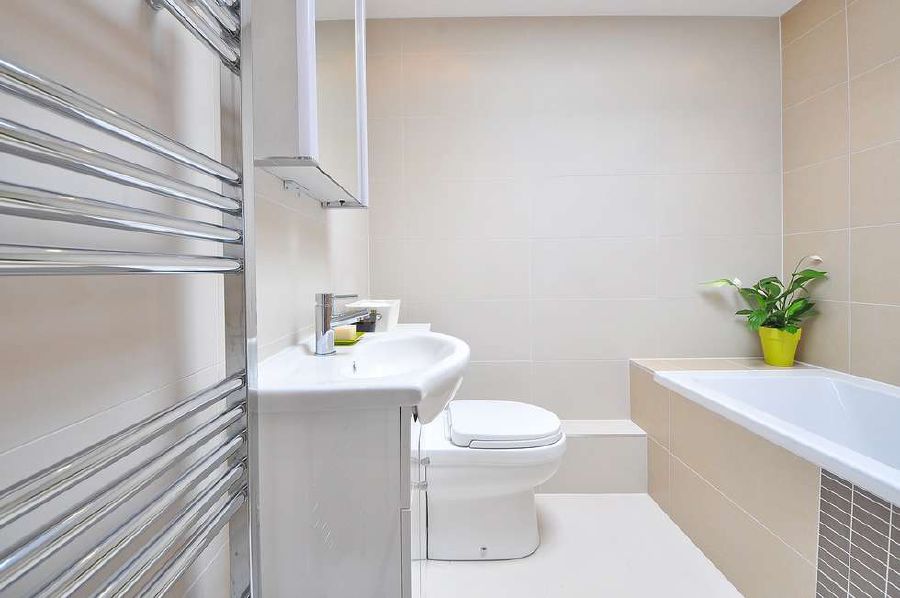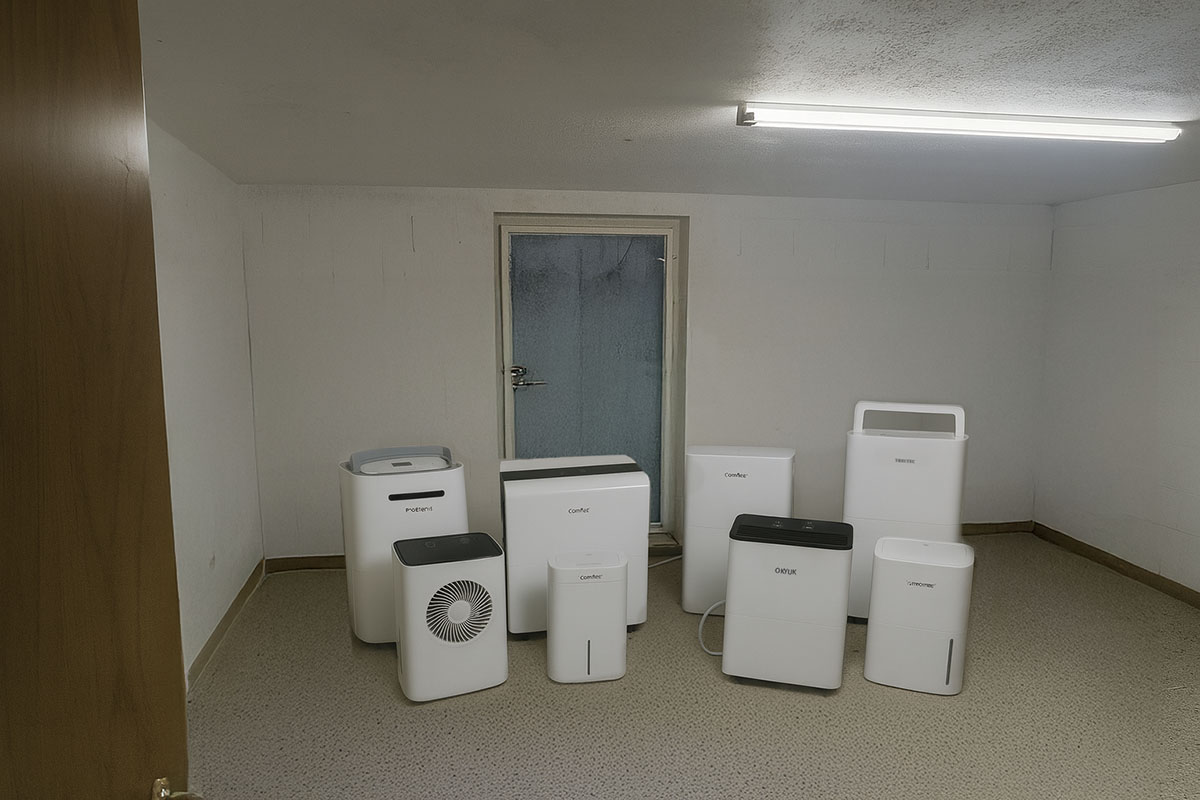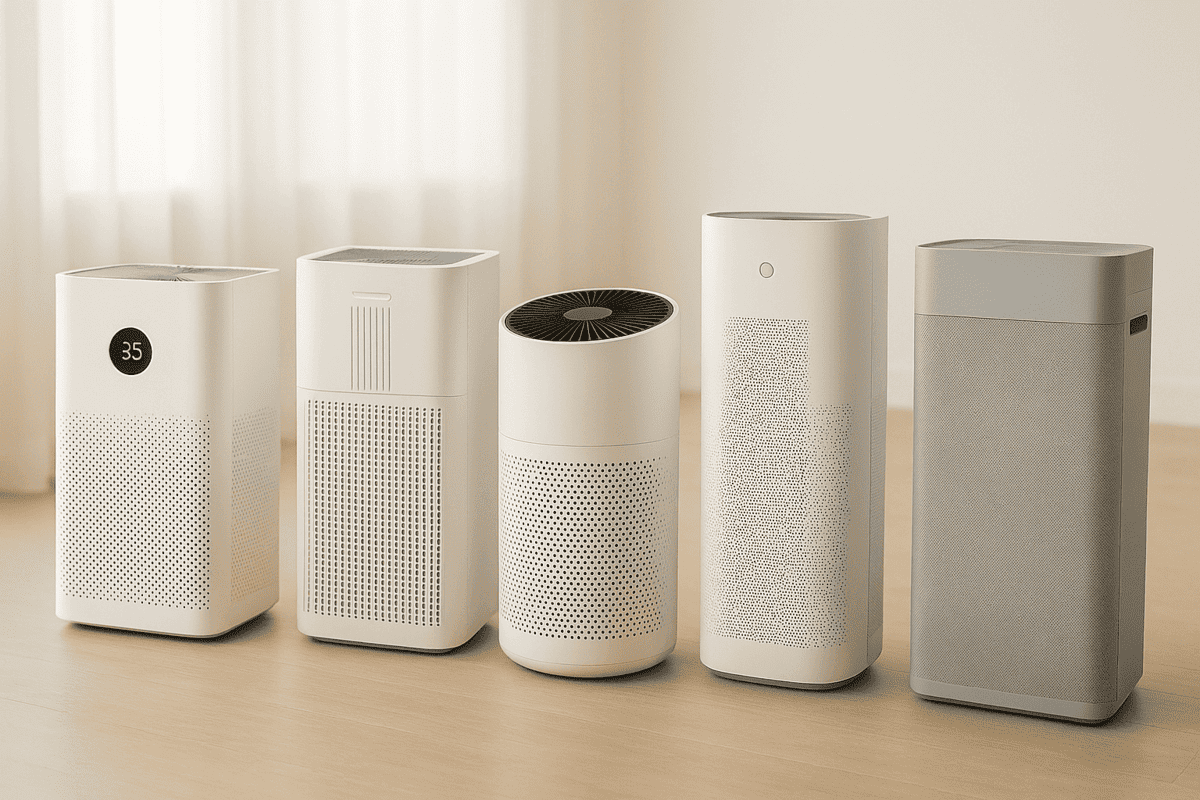Bathroom fan in comparison: against excessive humidity!
Bathroom fans are useful aids for ventilating indoor spaces. They regulate the humidity in the room air. In this way, they help to prevent mould.
In this guide, I will explain what a bathroom fan does, when it makes sense to use it and what is important when it comes to a bathroom fan. I will also introduce you to recommended models with and without a humidity sensor.
Recommended bathroom fans
- Bosch 1500 (test winner)
- Master builder
- Awenta
- Bosch 1900 (Best with sensor)
But first let's take a look at where and why it makes sense to use it.
Why a bathroom fan?
As the name suggests, this small fan is primarily installed in bathrooms. However, it is not limited to this: In principle, it can be used in any room with high humidity be of use. These include...
- Kitchen
- Fitness room
- Room with lots of plants
The main task of a bathroom fan is to equalise so-called Moisture peaks. This refers to periods with comparatively high to very high humidity.
It also works in the bathroom and kitchen bad odours by drawing in the air from the room and thus exchanging it.
A moisture peak occurs, for example, when showering, bathing or when cooking a lot. Water vapour is created. The room air is then very humid and water may already be deposited on the window panes or tiles.
This is precisely when the fan comes into play. It reduces the air humidity back to normal. For example, if the fan is connected to the bathroom light switch, it will not run all day, but only as long as you are in the bathroom.
Even better, however, are devices that automatically measure the humidity or have a motion sensor. But more on this later.
How a bathroom fan works
The funny thing about this fan is that it is connected to a ventilation shaft. This means that it draws in the air from the room and transports it outside.
The advantage is that the humidity does not have to be regulated as with a Dehumidifier is collected, but disposed of. This means you don't have to regularly look after a small water container.
The disadvantage is undoubtedly that an air shaft with a suitable opening is required to which you can attach a bathroom fan. But in most bathrooms that need such a device, such a ventilation shaft is available.
These shafts are often found in bathrooms without windowsfrom which the moisture cannot be removed in any other way. However, there are also bathrooms where the windows are simply too small or where the layout of the floor prevents a proper draught. In these cases, such a fan makes sense.
Differences in the range of functions
As with many products, there are different versions, each of which has its advantages and disadvantages. Last but not least, it is the range of functions that ultimately determines the price of the device.
So let's take a look at the main functions and whether they offer any real added value.
Non-return flap
This function is not to be sneezed at: After all, the appliance is connected to the outside world via a ventilation shaft. There are often non-return flaps in these shafts themselves. Depending on the size and structure of the shaft or shaft system, however, there may be a unpleasant draught come.
A non-return flap counteracts this. It only allows air to pass in one direction - outwards. It also prevents the Reduced heat loss.
Coupling with the light switch
Exactly how the bathroom fan is switched depends not only on the device, but also on its installation. However, models that can be linked to a light switch are not a bad idea.
You probably spend less time in the bathroom than in the living room or bedroom. It is therefore practical if the fan only runs when you are in the room. After all, as long as nobody is using the bathroom, there will be no peak humidity.
However, the connection to the light switch is not the last word in wisdom. What happens if you leave the bathroom after showering, switch off the light, but the humidity is still too high?
Even a fan with Motion detector cannot be solved. Although it makes coupling with a light switch superfluous, it only switches on when you are in the room.
Overrun function
The overrun function solves the problem just mentioned - at least in part. It provides a Longer running time of the fan.

Assuming you leave the bathroom after a hot shower, the appliance will continue to ventilate for some time. This reduces the likelihood of the bathroom fan switching off before the humidity peak has been regulated.
Hygrometer
With a built-in hygrometer the device can measure the humidity and switch itself on or off based on this measured value. This means that the overrun function is effectively superfluous.
In my opinion, bathroom fans with hygrometers are a very clever purchase. They only ventilate when they are actually needed. Appliances without a hygrometer always run the risk of being switched on either too long or too short. This results in unnecessarily high energy consumption or excessive humidity. The latter is known to lead to mould and nobody wants that in their home.
On some models, you can set how high the humidity must be for the bathroom fan to start. So if it provides too dry air ex works or removes too little humidity, you can correct this by changing the setting.
Start-up delay
The start-up delay combats a problem that some bathroom fans unfortunately have: their running speed. It's not that loud per se. If you like to remain completely undisturbed during your morning routine in the bathroom, you might still notice it negatively.
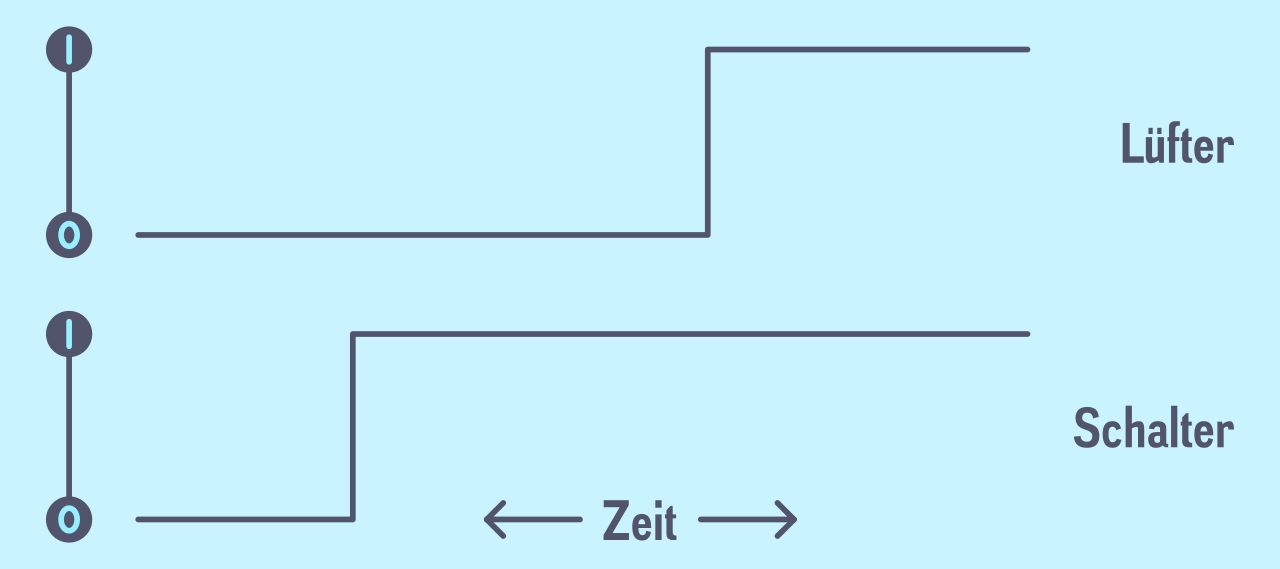
The start-up delay - you've probably already guessed it Offsets the time of switching on a few minutes later. Ideally, you should be out of the bathroom long before the fan starts working.
Depending on the fan, the delay can be set on the appliance. However, it should not be too long, as removing moisture promptly prevents mould growth.
Bathroom fan with remote control
In my opinion, the remote control is a rather over-engineered solution. It can be used to control some models quite precisely. But who wants to think about it at all?
I much prefer an automatic fan. It does its job without asking. That's enough for me.
Speed controller
The number of revolutions per minute has an influence on three things:
- Air circulation per time
- Energy consumption
- Volume
The Air circulation simply refers to the amount of air that the fan moves in the ventilator. The faster the rotor blades turn, the faster the air is transported into the ventilation shaft.
The more revolutions per minute the fan has to perform, the more Energy consumed er. It is important to weigh up energy consumption against the speed at which the moisture peak is removed.
In addition, a faster rotor louder noises do. However, it may well be that you would prefer to hear the fan for a shorter time and louder than quietly but for a longer time. To determine this setting, a bathroom fan requires a speed controller.
Bathroom fan runtime calculator
Criteria when buying a bathroom fan
We have looked at what bathroom fans are and what they can do. Now we summarise this knowledge in the following purchase criteria:
- Air circulation
- Energy consumption
- Volume
- Automatic on/off switch
- Price
In my opinion, the most important factor is how much air the bathroom fan actually moves. The majority of manufacturers provide precise information on this in cubic metres of air per hour. Values of around 100 cubic metres per hour are not wrong. I wouldn't go much lower than that.
The Energy consumption is also specified by most reputable manufacturers. At this point, I would recommend models that run on a maximum of 15 watts. This puts the appliance as an electrical consumer close to good energy-saving lamps.
The Volume of the device is the third most important purchase criterion. You can be a decisive criterion, depending on taste. If the fan is used in the bathroom, then I would weigh up the volume as a slightly higher factor than if it is used in the kitchen. The tiled walls in the bathroom tend to absorb sound rather poorly, which is why it can sometimes be perceived as louder in the bathroom.
How and when the bathroom fan switches on can be crucial. After all, you want to operate it efficiently and, if possible, not notice it working at all. This can be ensured by an appropriate automatic system that switches the fan on depending on the humidity. Time-delayed switching on and off offers additional comfort.
The Price is of course also important. Fortunately, there is also plenty of choice when it comes to bathroom fans. Practically every price range is represented among the models on offer. Even the models in the very low two-digit range offer a satisfactory range of functions.
This is largely determined by the Design and the Size about the costs. Of course, models with displays and other bells and whistles are also available. With a household item like this, I would still advise keeping it simple. The appliance is expected to work quietly and smoothly for years or decades without attracting attention. Flashing displays on the bathroom fan are rather counterproductive and often overpriced.
Recommended products
The variety of offers, models and functions is huge. The following list should give you an overview and make your decision a little easier.
So here are 4 recommended bathroom fans that have the most important functions and a good price-performance ratio.
1st place - Power pack for cellar & bathroom - Bosch Fan 1500 in the test
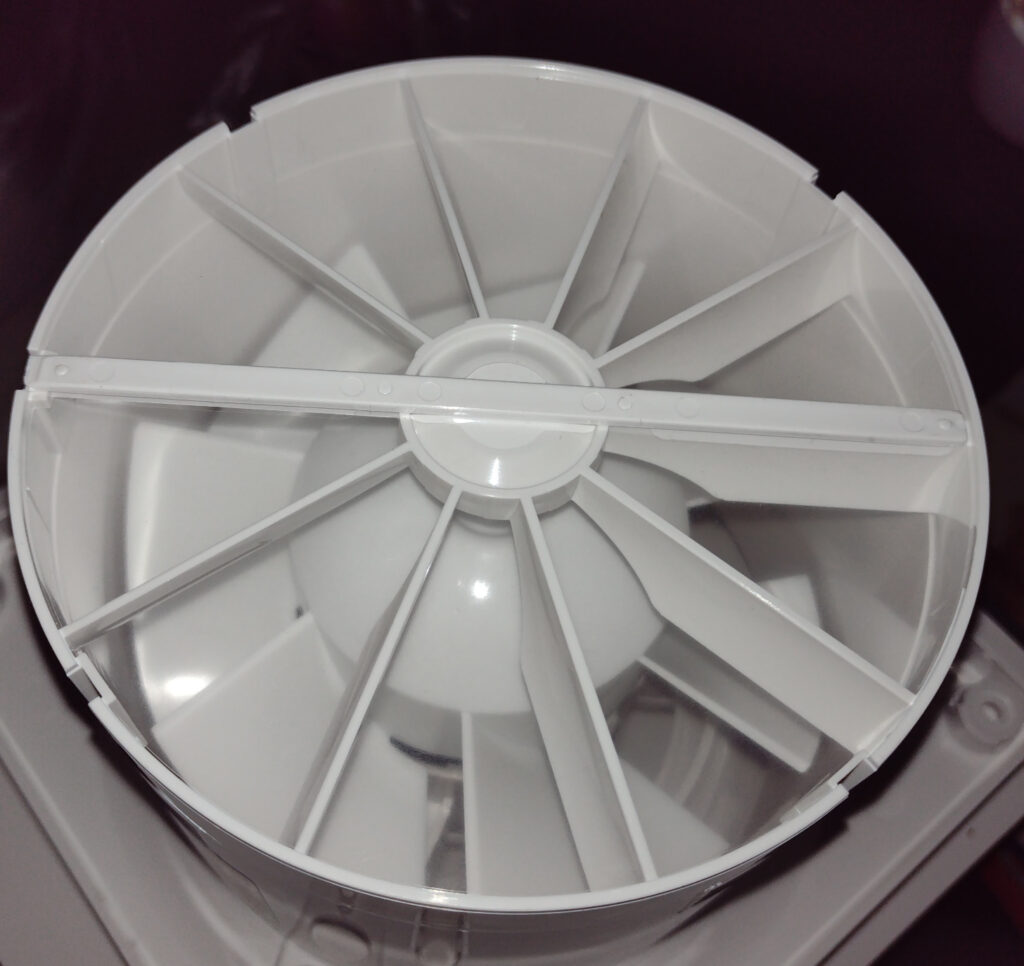

Of all the fans tested, the Bosch Fan 1500 DH impressed me the most - for me, it is clearly the best fan. Test winner. No other variant could keep up in terms of performance, suitability for everyday use and range of functions.
I use the fan in the basement, where humid air quickly builds up. Immediately after installation, I could feel how effectively it circulates the air - a real powerhouse. Even in problematic corners, the indoor climate improves significantly. A real game changer, especially in changeable weather conditions.
The modern, white design is simple but of high quality - and blends discreetly into any environment. Wall mounting was easy and everything you need is included. In my case, I opted for the version with humidity sensor (also available without sensor) . The highlight: the fan starts automatically as soon as a critical humidity value is reached. It couldn't be more practical!
Compared to other models, the Bosch Fan 1500 is significantly more powerful. However, this power also comes at a price - it is audible. Even when the door is closed, it can still be heard from the upper floor. This doesn't bother me, because efficiency is more important to me than absolute silence.
A real highlight is its compatibility with the Bosch Smart Home system. The fan can be easily automated via light switches or relays - a clear advantage over many other models. It runs completely independently throughout the day with individual control.
In short: the Bosch Fan 1500 DH delivers in all categories. No other model in the test came close to this overall performance. If you are looking for a reliable and well-designed fan for damp rooms, you will find it here.
Advantages
❌ Disadvantages
2nd place - Whisper-quiet helper for the bathroom - MEISTERBAU in the test
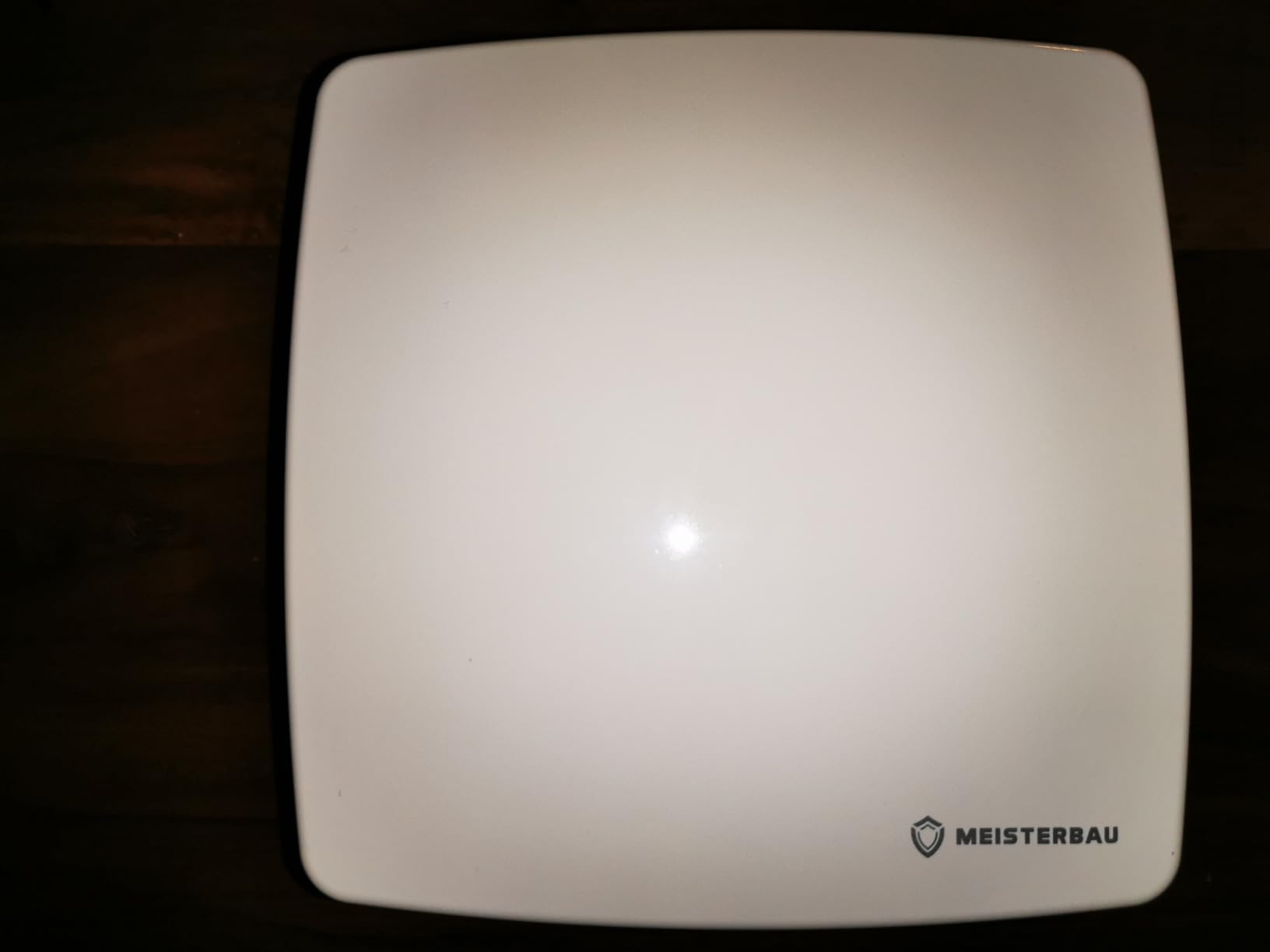
The MEISTERBAU bathroom fan is my personal favourite. 2nd place in comparison - and not without reason. Anyone who values particularly quiet operation will find a real highlight here. I have installed it in the utility room, where the washing machine and tumble dryer regularly cause high humidity levels.
The control via the integrated moisture sensor works precisely and reacts as soon as I take damp laundry out of the drum. The sensitivity can be adjusted directly on the circuit board with a small adjustment tool - this takes a little patience, but then works exactly as you need it to.
What particularly impressed me: The fan runs so quietly that you can have a conversation next to it without even noticing it. Despite the comparatively lower air performance compared to the test winner Bosch Fan 1500 DH, the MEISTERBAU is ideal for smaller rooms where the focus is on discreet, energy-efficient operation.
Installation was straightforward, only the cable entry and lack of strain relief could be better solved. The humidity settings also need to be adjusted occasionally depending on the time of year - the response behaviour changes slightly in winter in particular. Nevertheless, the fan performs reliably in typical bathroom or utility room scenarios.
Advantages
❌ Disadvantages
3rd place - Ultra-quiet mini fan for small rooms from Awenta

In my comparison, the "Mega Silent" wall fan (model KWS100 / Escudo Line) lands on a solid 3rd place - above all because of its extremely quiet operation. I installed it in a small guest bathroom where absolute silence is required - and that's exactly what it does.
It was noticeable when unpacking: The packaging is divided into two parts - the fan unit and front cover are supplied separately. This suggests that this is a modular system in which the cover can be replaced later - practical for anyone who wants to customise the design.
During the first test run without installation, it was immediately clear that the noise level is extremely low. As soon as the door is closed, the fan is practically inaudible from the outside. This makes it ideal for bathrooms that are directly adjacent to bedrooms or are used at night. It also looks sleek - however, my version had a manufacturer's imprint on the front that was not visible in the product photos.
What you should know: The flow rate of approx. 75 m³/h is on the lower end - sufficient for smaller rooms, but not for very damp cellars or large bathrooms. A non-return flap is not included as standard - you should bear this in mind when using in cooler external walls.
Instructions were only available in English, but installation was straightforward. For the price, the fan delivers a lot of silence and solid quality. If you are looking for maximum performance, you are better off with other models - but if you are looking for ultra quiet is exactly right here.
Advantages
❌ Disadvantages
The best bathroom fan with humidity sensor in the test
Made for modern bathrooms - Bosch 1900 DH Bathroom fan with humidity sensor

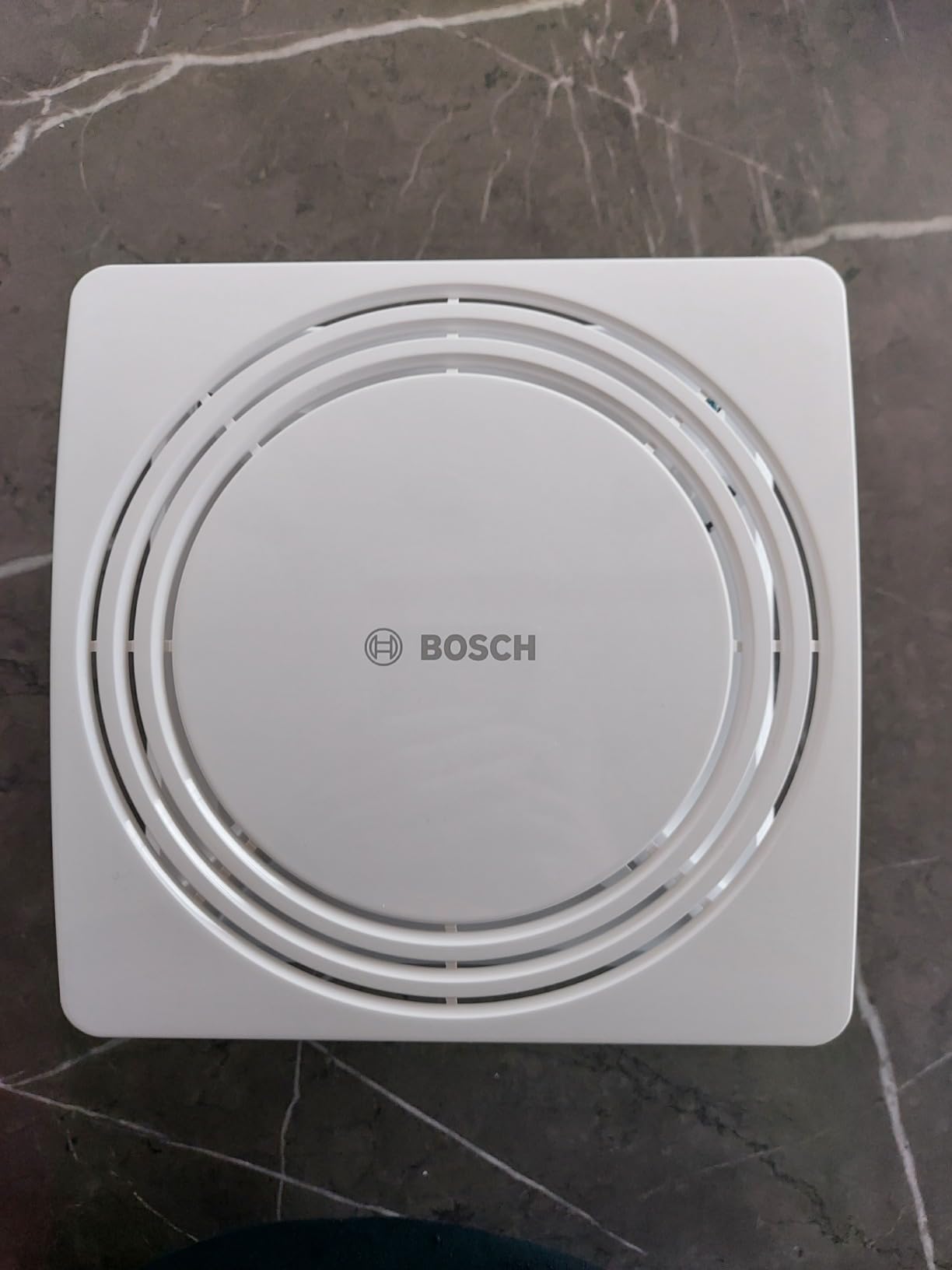
The Bosch 1900 DH W100/W125 is a modern bathroom fan with a humidity sensor that scores particularly highly with its quiet, automatic operation. In my test, it made it to the 1st place for bathroom fans with humidity sensors above all because of the successful combination of design, performance and ease of use.
The fan was used in a modernised bathroom - the challenge: high humidity after showering, no window, little air exchange. The Bosch fan switches on automatically as soon as the humidity rises above the set threshold value (in my case approx. 60 %) and switches off again just as reliably when the air is dry. This automatic function makes it particularly suitable for everyday use.
Installation was quick, but connecting the cable is a little fiddly - a more accessible terminal would be desirable here. The fan itself is excellently manufactured, does not rattle and blends unobtrusively into the bathroom design with its neutral white housing.
Despite the whisper-quiet 38 dB, the effect is clearly noticeable: After showering, the mirror hardly mists up and the air is quickly fresh again. Particularly pleasing for me: no annoying hum as with many cheap models.
The Bosch also proved to be a reliable "booster" in combination with a central ventilation system, e.g. via a smart home solution such as Shelly & HomeAssistant.
Conclusion: A Very quiet, smart bathroom fanwhich impresses with well thought-out details - ideal for modern bathrooms without windows.
Advantages
❌ Disadvantages
Quiet all-rounder with automatic - Maico ECA in test
The Maico ECA 100 ipro H is a two-stage small room fan with fully automatic humidity control that comes directly behind the Bosch 1900. It is particularly suitable for all those who value Discreet background noise and Automatic control but can live with minor restrictions.
I used the Maico fan in a small bathroom as well as in a laundry room. The special feature: the fan works in two stages. At level 1 it is barely audible, at level 2 it is still pleasant - a big difference to the louder Bosch FAN 1500. This is a real plus, especially in sensitive residential areas (e.g. if the fan leads onto a terrace).
What is a bit of a shame is that the operating instructions are not particularly user-friendly and the humidity threshold value is not very high. Not adjustable - It is preset to around 60 %. This can work, but is not always ideal depending on the room and climate. At the height of summer or with certain air currents, the fan starts up somewhat irregularly, which leaves the impression of a certain "moodiness".
On the other hand, the well thought-out combination of manual push-button operation with run-on time and fully automatic humidity mode is positive. Installation was largely problem-free, only the cable entry at the top right is unusual - anyone who has already installed other models here may have to rework it.
Conclusion: A well-manufactured fan with Quiet operationThe machine offers a wide range of functions, useful functions and a solid automatic system - but without the option of adjusting the humidity and a somewhat "individual character". Nevertheless, a sensible choice for many applications.
Advantages
❌ Disadvantages
FAQs on the subject of bathroom fans
1 Why is a bathroom fan important for humidity control?
A bathroom fan helps to regulate the humidity in the bathroom. After a shower or bath, the humidity can rise sharply, which can lead to condensation and mould growth. The fan extracts the humid air and thus ensures a dry and healthy room climate.
2 What room size is a bathroom fan suitable for?
The capacity of a bathroom fan should be adapted to the size of the room. Small bathrooms require fans with a lower air circulation rate (measured in m³/h), while larger rooms require more powerful fans. A general recommendation is a fan with a capacity of 60-100 m³/h for smaller bathrooms and up to 150 m³/h for larger bathrooms.
3. how long should a bathroom fan run after showering?
A bathroom fan should run for around 10-15 minutes after showering or bathing in order to completely remove the moist air. Some fans have an automatic run-on function that keeps the fan running for a certain time after the light has been switched off.
4 How efficient are modern bathroom fans?
Modern bathroom fans are energy-efficient and often equipped with sensors that automatically react to high humidity. They are designed to extract air effectively with minimal energy consumption. Fans with energy labels and EC motors are particularly energy-efficient.
5 What additional functions do bathroom fans offer?
Some bathroom fans offer additional functions such as humidity sensors that switch the fan on automatically when a certain humidity level is reached. Other models have motion detectors or timers to automate operation. There are also fans with low-noise motors for a more pleasant user experience.
6 What should I bear in mind when installing a bathroom fan?
When installing a bathroom fan, it is important to plan the air flow correctly. The fan should be positioned so that it efficiently discharges the moist air to the outside. Local regulations and safety requirements must also be observed, particularly with regard to cabling and connection to the power supply.
Conclusion
To summarise, when choosing the right bathroom fan, I would look for a product that does little work. As mentioned earlier, good fans are the ones you don't notice at all. In short an optimal bathroom fan:
- Eliminate humidity
- be quiet
- have a humidity sensor
- have an automatic start-up and run-on function
- Consume little energy
- look appealing
I very much hope that this article has helped you with your decision. The more informed you are when buying, the better your decision will be.
Admittedly: At first glance, the topic is more extensive than you might think. That's why it's worth taking a few minutes to find the right product for you. Good luck and see you next time at luftzug.org 🙂
